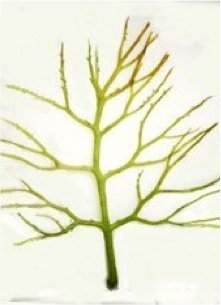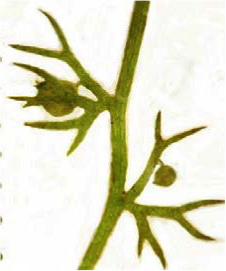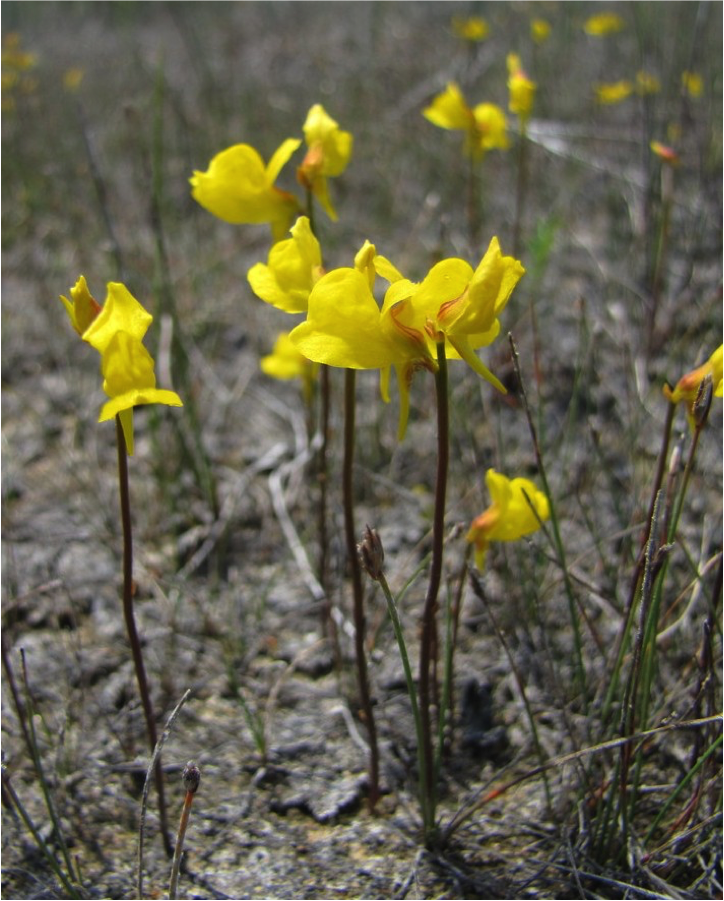Plants with Stomachs
Somewhere in a lake near you, in a shallow bay, grows a floating plant with pouchlike sacs on its leaflets. The sacs each have a “spring- loaded” trap door that can open and shut in a fraction of a second. The “triggers” are hairs, known as “trichomes” in plants, around the mouth of the sac. It’s a “touch me and you’ll die” trichome.
As the plant lies out floating on the water’s surface, basking in the sun’s rays to power its chloroplasts, a tiny water creature wiggles by and touches a hair. SNAP! The door opens, the creature is sucked in, the door snaps shut, and digestion begins. The sacs are more akin to stomachs that digest than bladders that excrete, but that’s the name they were given.
A Hollywood sci-fi story? No. Mother Nature’s science fiction? Almost. Plants that live in nutrient-poor soils or waters profit with their side business of capturing prey and using those nutrients. The pitcher plants do it, the sundews do it, and so do the bladderworts.
The genus Utricularia has many species, but in northeast Illinois you’ll likely encounter four species in inland lakes and in wet swales along Lake Michigan. You can see the masses of yellow flowers from boardwalks such as those at Moraine Hills State Park in McHenry County, or Volo Bog in Lake County. The yellow flower heads rise straight up out of the water from the stems, sometimes rooted, often floating.


(Left): Leaves of Utricularia macrorhiza (right): U. macrorhiza has 2 mm sacs on the leaves. Photos by Linda Curtis.
Two bladderwort species, U. macrorhiza, common bladderwort (pictured above), and U. gibba, humped bladderwort (pictured below), have round threadlike leaves, rather than flattened ones. U. macrorhiza has 2 mm sacs on the leaves, oval in one view, flattened from the side. U. gibba is smaller with 1 mm sacs on the stem rather than on the leaves.

Utricularia gibba, humped bladderwort, has 1 mm bladders, often scattered on the stem next to tiny, threadlike leaves.
U. minor, small bladderwort, has sacs about 1 mm in size that are attached to the tiny, flat leaves. U. intermedia, flat-leaved bladderwort, has bladders on separate branches and its leaves are spiny.

If you don’t carry a ruler you may want to learn a body dimension to help in the field. Find a 1 or 2 mm mole on your arm to use as a reference. This was a requirement of my students in botany lab.
Along Lake Michigan, you may see the pretty yellow flowers of U. cornuta, horned bladderwort, named for the long spur on the flower. Its flowers do not arise from a basal whorl of leaves as with other species. It grows aside a marsh with Carex buxbaumii, the purple-scaled sedge, and the sedges Carex aurea, C. conoidea, and C. viridula.
A Hollywood sci-fi story? No. Mother Nature’s science fiction? Almost. Plants that live in nutrient-poor soils or waters profit with their side business of capturing prey and using those nutrients. The pitcher plants do it, the sundews do it, and so do the bladderworts.

The sacs of Utricularia species are a bit flattened, not completely round, and if you do more research on this amazing group of plants you’ll learn the sacs contract on the sides, creating a vacuum that pulls the prey in once the hair is triggered.
Another interesting “trick” are the turions, the terminal buds that break off the plant and float away to begin life on a different site, wherever wind and waves take them.
There’s more, and the more you read, the more amazed you’ll be, and the more thankful you’ll be that they are minute.

